The Impact of Decreasing Global Oil Prices on UK E&P Companies
VerifiedAdded on 2020/04/21
|54
|13064
|105
Thesis and Dissertation
AI Summary
This dissertation investigates the impact of the decline in global crude oil prices on exploration and production companies in the UK, particularly those operating in the North Sea region. The research utilizes secondary data to analyze the effects of the price fall on employment levels, capital investment, and the profitability of these companies. The study explores the causes of the oil price decline and examines its consequences, highlighting the significant negative impact on the oil and gas industry, especially given the high production costs in the UK. The research also assesses the future prospects of the UK's oil and gas sector in the context of sustained low oil prices, providing recommendations for the industry. The dissertation covers background information, literature review, research methodology, data analysis, and conclusions, offering a comprehensive overview of the challenges and opportunities faced by UK oil and gas companies in a volatile global market. The study emphasizes the industry's role in the UK economy and how it has responded to the crisis generated by the falling oil prices.
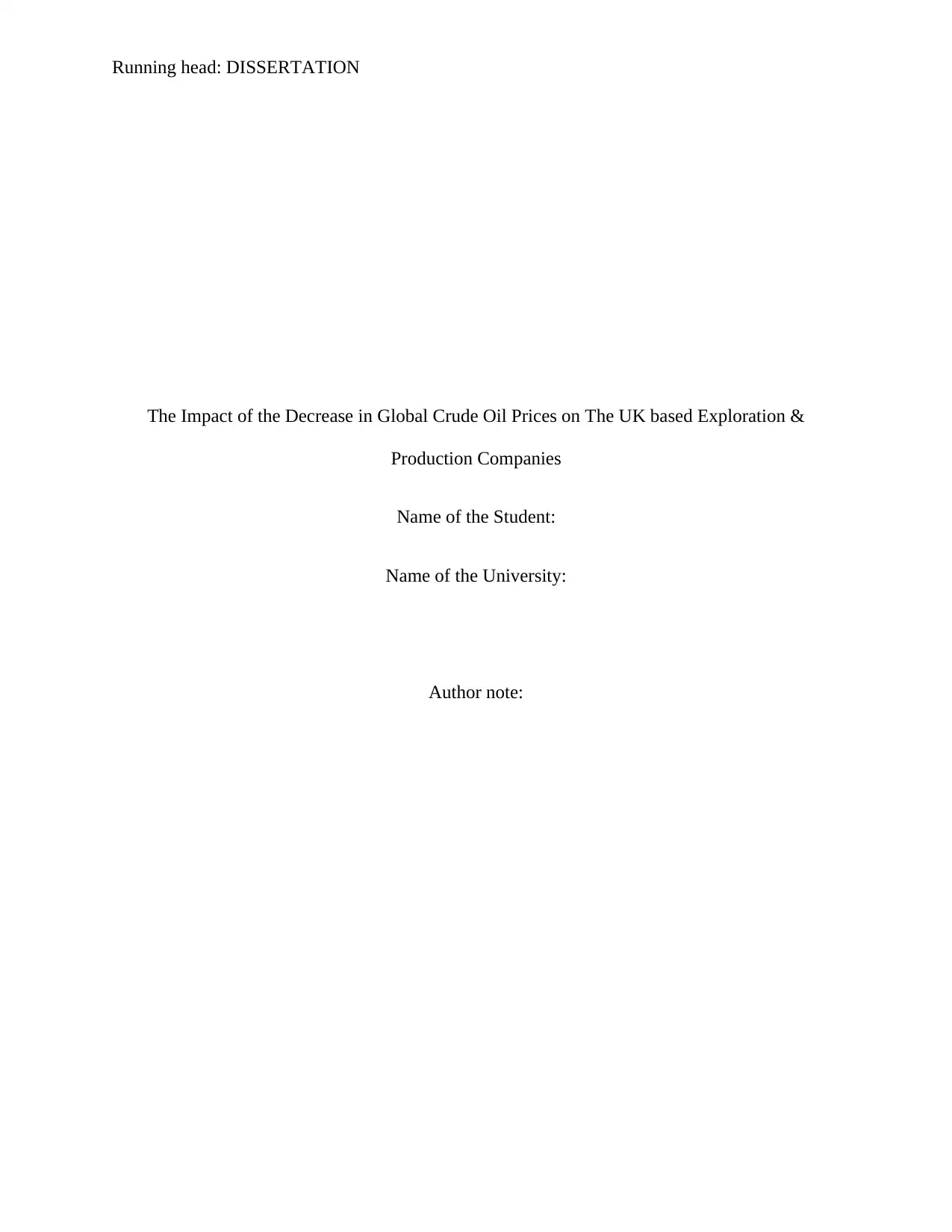
Running head: DISSERTATION
The Impact of the Decrease in Global Crude Oil Prices on The UK based Exploration &
Production Companies
Name of the Student:
Name of the University:
Author note:
The Impact of the Decrease in Global Crude Oil Prices on The UK based Exploration &
Production Companies
Name of the Student:
Name of the University:
Author note:
Paraphrase This Document
Need a fresh take? Get an instant paraphrase of this document with our AI Paraphraser
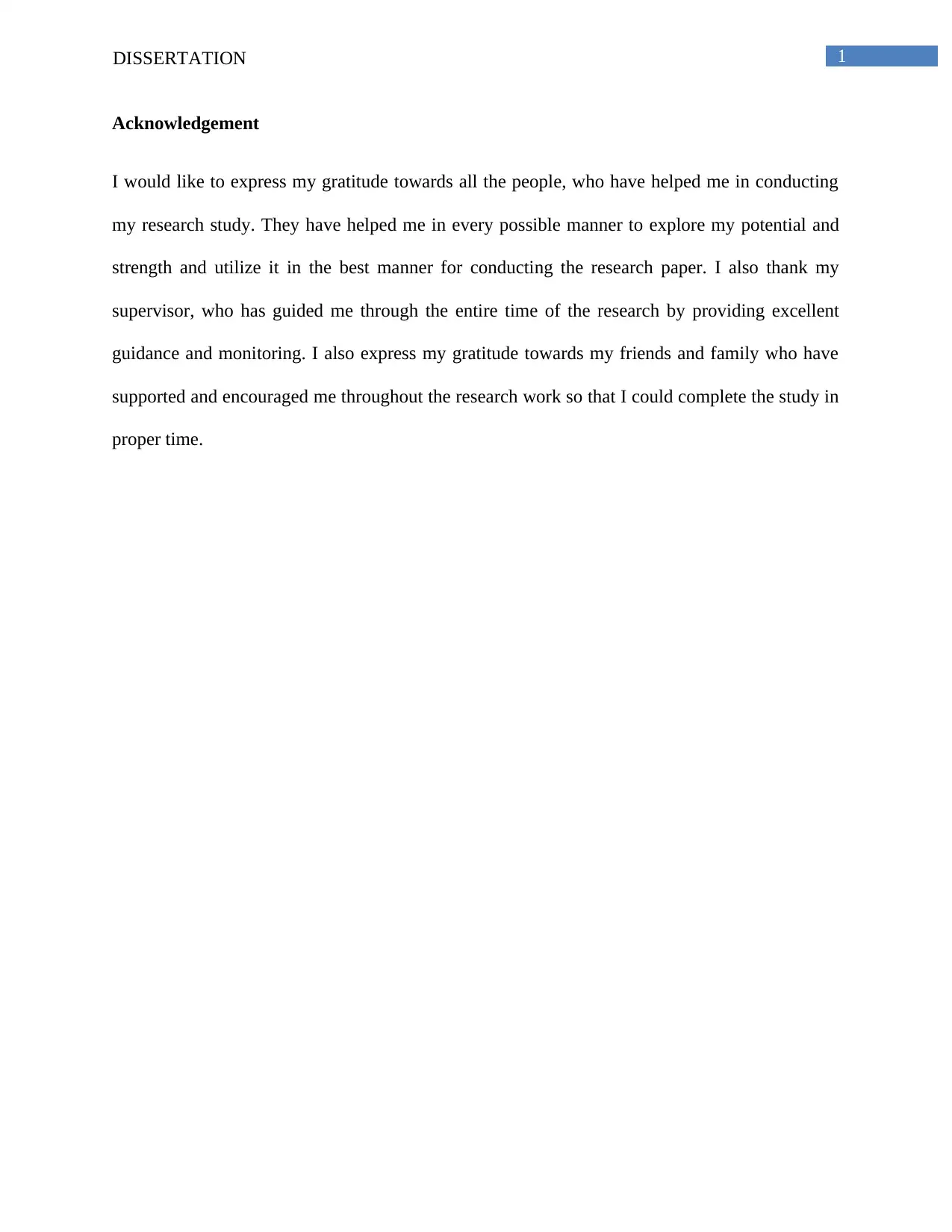
1DISSERTATION
Acknowledgement
I would like to express my gratitude towards all the people, who have helped me in conducting
my research study. They have helped me in every possible manner to explore my potential and
strength and utilize it in the best manner for conducting the research paper. I also thank my
supervisor, who has guided me through the entire time of the research by providing excellent
guidance and monitoring. I also express my gratitude towards my friends and family who have
supported and encouraged me throughout the research work so that I could complete the study in
proper time.
Acknowledgement
I would like to express my gratitude towards all the people, who have helped me in conducting
my research study. They have helped me in every possible manner to explore my potential and
strength and utilize it in the best manner for conducting the research paper. I also thank my
supervisor, who has guided me through the entire time of the research by providing excellent
guidance and monitoring. I also express my gratitude towards my friends and family who have
supported and encouraged me throughout the research work so that I could complete the study in
proper time.
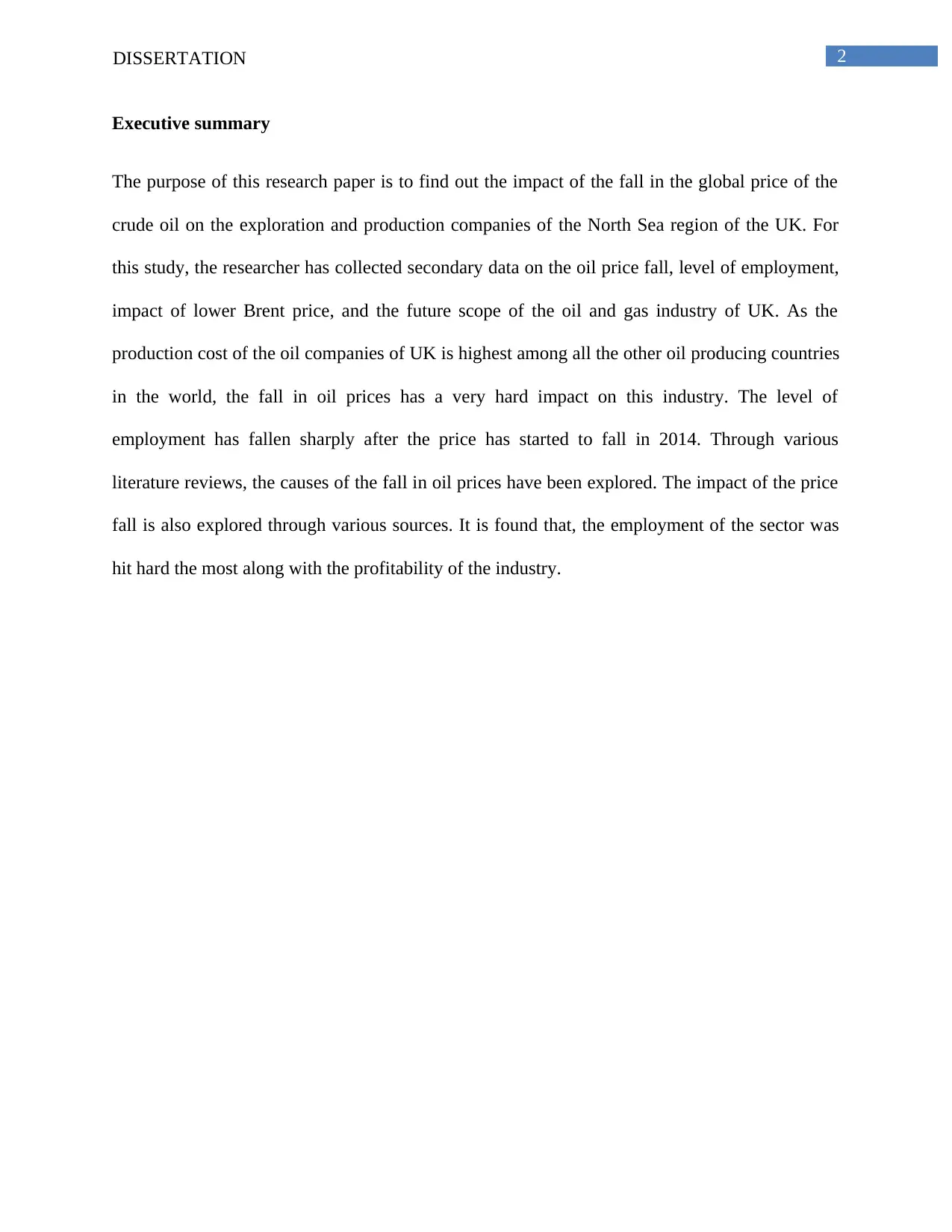
2DISSERTATION
Executive summary
The purpose of this research paper is to find out the impact of the fall in the global price of the
crude oil on the exploration and production companies of the North Sea region of the UK. For
this study, the researcher has collected secondary data on the oil price fall, level of employment,
impact of lower Brent price, and the future scope of the oil and gas industry of UK. As the
production cost of the oil companies of UK is highest among all the other oil producing countries
in the world, the fall in oil prices has a very hard impact on this industry. The level of
employment has fallen sharply after the price has started to fall in 2014. Through various
literature reviews, the causes of the fall in oil prices have been explored. The impact of the price
fall is also explored through various sources. It is found that, the employment of the sector was
hit hard the most along with the profitability of the industry.
Executive summary
The purpose of this research paper is to find out the impact of the fall in the global price of the
crude oil on the exploration and production companies of the North Sea region of the UK. For
this study, the researcher has collected secondary data on the oil price fall, level of employment,
impact of lower Brent price, and the future scope of the oil and gas industry of UK. As the
production cost of the oil companies of UK is highest among all the other oil producing countries
in the world, the fall in oil prices has a very hard impact on this industry. The level of
employment has fallen sharply after the price has started to fall in 2014. Through various
literature reviews, the causes of the fall in oil prices have been explored. The impact of the price
fall is also explored through various sources. It is found that, the employment of the sector was
hit hard the most along with the profitability of the industry.
⊘ This is a preview!⊘
Do you want full access?
Subscribe today to unlock all pages.

Trusted by 1+ million students worldwide

3DISSERTATION
Table of Contents
Chapter 1: Introduction....................................................................................................................6
1.1 Introduction............................................................................................................................6
1.2 Background of the study........................................................................................................7
1.3 Research aim..........................................................................................................................8
1.4 Research objectives...............................................................................................................8
1.5 Research questions.................................................................................................................8
1.6 Problem statement.................................................................................................................9
1.7 Rationale of the research.......................................................................................................9
1.8 Structure of the research......................................................................................................10
Chapter 2: Literature Review.........................................................................................................11
2.1 Introduction..........................................................................................................................11
2.2 Background..........................................................................................................................11
2.2.1 Oil and gas industry of UK...........................................................................................11
2.2.2 Causes for fall in the global crude oil price..................................................................13
2.2.3 Fall in global crude oil prices: Winners and losers.......................................................15
2.2.4 Impact of falling oil price on the E&P companies of UK and North Sea Region........17
2.3 Conceptual framework.........................................................................................................18
Chapter 3: Research Methodology................................................................................................19
3.1 Introduction..........................................................................................................................19
Table of Contents
Chapter 1: Introduction....................................................................................................................6
1.1 Introduction............................................................................................................................6
1.2 Background of the study........................................................................................................7
1.3 Research aim..........................................................................................................................8
1.4 Research objectives...............................................................................................................8
1.5 Research questions.................................................................................................................8
1.6 Problem statement.................................................................................................................9
1.7 Rationale of the research.......................................................................................................9
1.8 Structure of the research......................................................................................................10
Chapter 2: Literature Review.........................................................................................................11
2.1 Introduction..........................................................................................................................11
2.2 Background..........................................................................................................................11
2.2.1 Oil and gas industry of UK...........................................................................................11
2.2.2 Causes for fall in the global crude oil price..................................................................13
2.2.3 Fall in global crude oil prices: Winners and losers.......................................................15
2.2.4 Impact of falling oil price on the E&P companies of UK and North Sea Region........17
2.3 Conceptual framework.........................................................................................................18
Chapter 3: Research Methodology................................................................................................19
3.1 Introduction..........................................................................................................................19
Paraphrase This Document
Need a fresh take? Get an instant paraphrase of this document with our AI Paraphraser
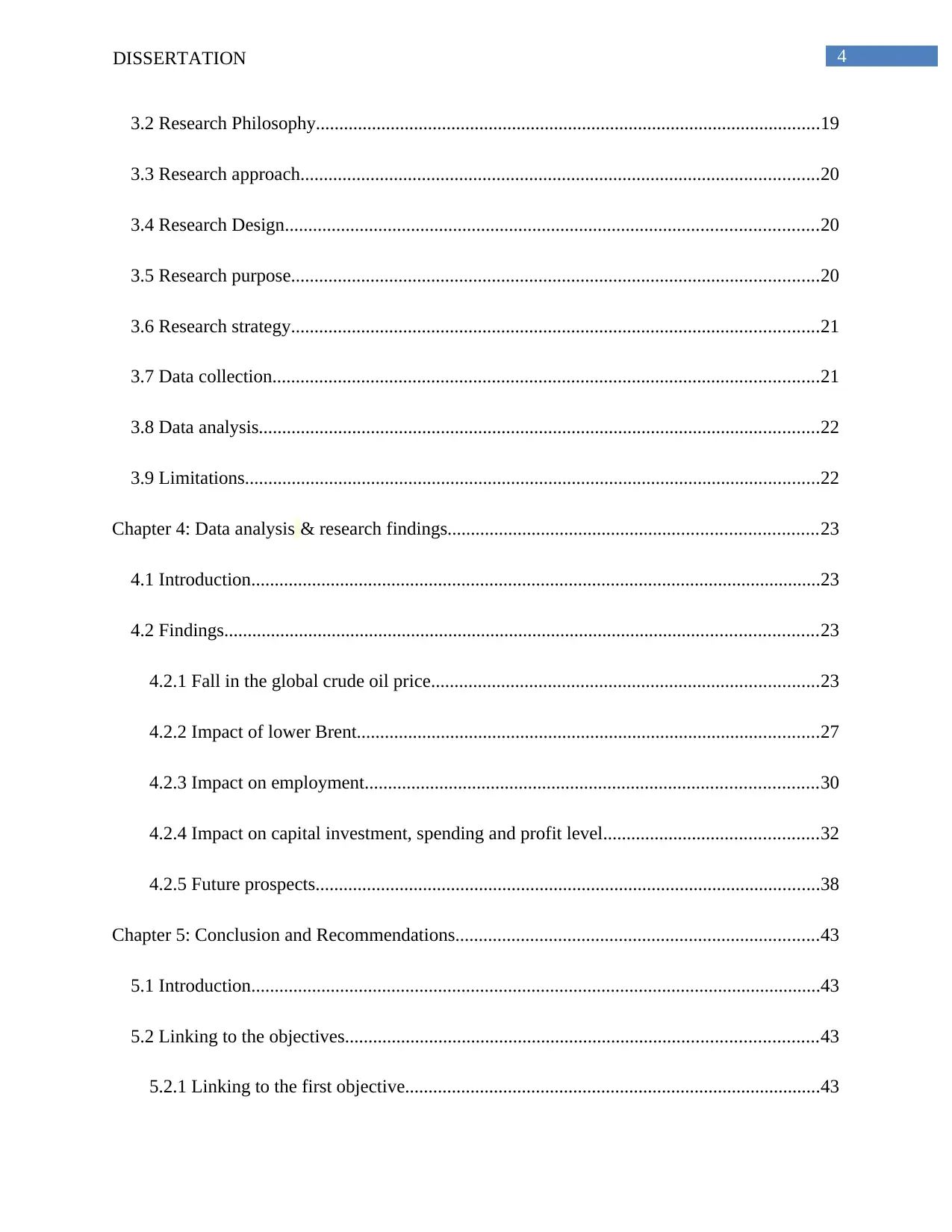
4DISSERTATION
3.2 Research Philosophy............................................................................................................19
3.3 Research approach...............................................................................................................20
3.4 Research Design..................................................................................................................20
3.5 Research purpose.................................................................................................................20
3.6 Research strategy.................................................................................................................21
3.7 Data collection.....................................................................................................................21
3.8 Data analysis........................................................................................................................22
3.9 Limitations...........................................................................................................................22
Chapter 4: Data analysis & research findings...............................................................................23
4.1 Introduction..........................................................................................................................23
4.2 Findings...............................................................................................................................23
4.2.1 Fall in the global crude oil price...................................................................................23
4.2.2 Impact of lower Brent...................................................................................................27
4.2.3 Impact on employment.................................................................................................30
4.2.4 Impact on capital investment, spending and profit level..............................................32
4.2.5 Future prospects............................................................................................................38
Chapter 5: Conclusion and Recommendations..............................................................................43
5.1 Introduction..........................................................................................................................43
5.2 Linking to the objectives.....................................................................................................43
5.2.1 Linking to the first objective.........................................................................................43
3.2 Research Philosophy............................................................................................................19
3.3 Research approach...............................................................................................................20
3.4 Research Design..................................................................................................................20
3.5 Research purpose.................................................................................................................20
3.6 Research strategy.................................................................................................................21
3.7 Data collection.....................................................................................................................21
3.8 Data analysis........................................................................................................................22
3.9 Limitations...........................................................................................................................22
Chapter 4: Data analysis & research findings...............................................................................23
4.1 Introduction..........................................................................................................................23
4.2 Findings...............................................................................................................................23
4.2.1 Fall in the global crude oil price...................................................................................23
4.2.2 Impact of lower Brent...................................................................................................27
4.2.3 Impact on employment.................................................................................................30
4.2.4 Impact on capital investment, spending and profit level..............................................32
4.2.5 Future prospects............................................................................................................38
Chapter 5: Conclusion and Recommendations..............................................................................43
5.1 Introduction..........................................................................................................................43
5.2 Linking to the objectives.....................................................................................................43
5.2.1 Linking to the first objective.........................................................................................43
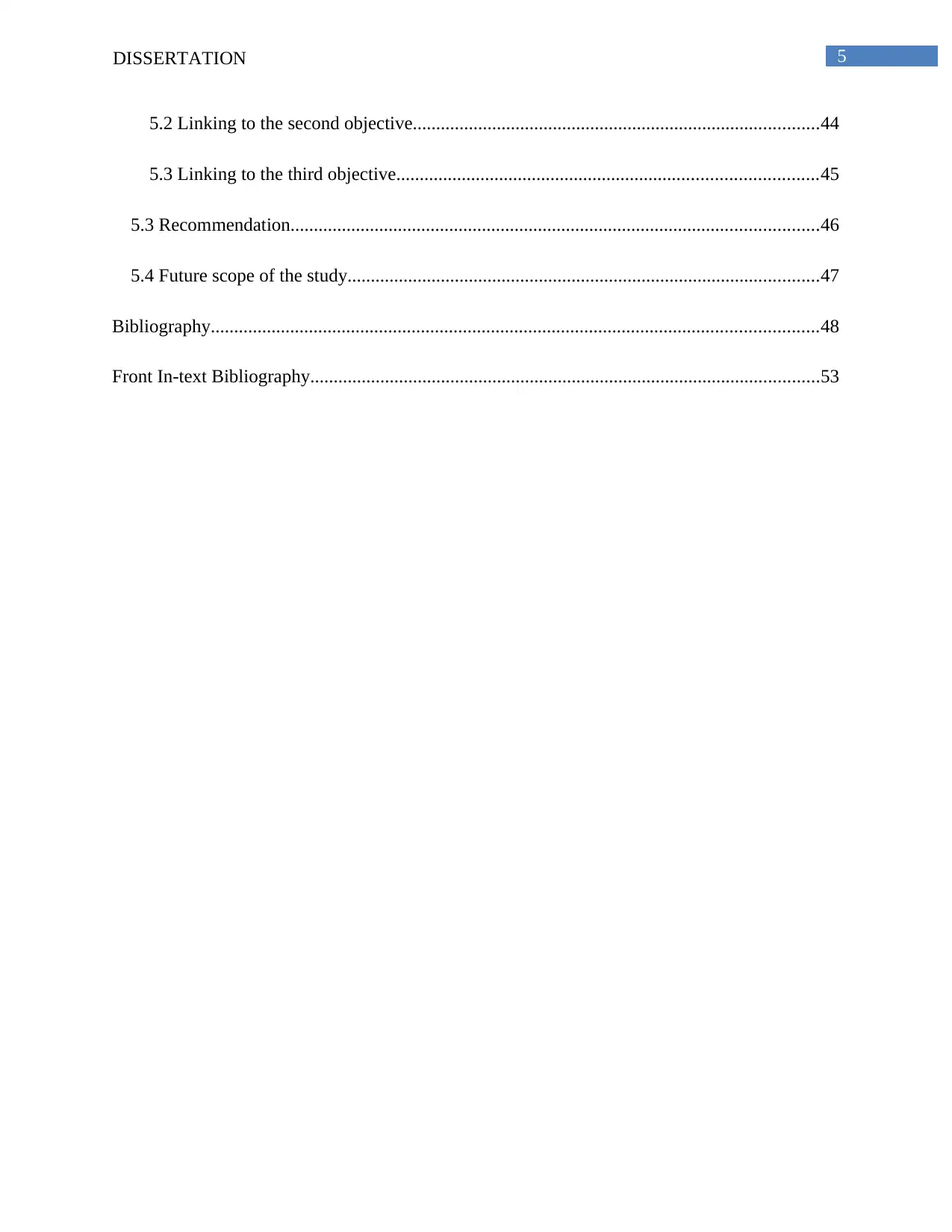
5DISSERTATION
5.2 Linking to the second objective.......................................................................................44
5.3 Linking to the third objective..........................................................................................45
5.3 Recommendation.................................................................................................................46
5.4 Future scope of the study.....................................................................................................47
Bibliography..................................................................................................................................48
Front In-text Bibliography.............................................................................................................53
5.2 Linking to the second objective.......................................................................................44
5.3 Linking to the third objective..........................................................................................45
5.3 Recommendation.................................................................................................................46
5.4 Future scope of the study.....................................................................................................47
Bibliography..................................................................................................................................48
Front In-text Bibliography.............................................................................................................53
⊘ This is a preview!⊘
Do you want full access?
Subscribe today to unlock all pages.

Trusted by 1+ million students worldwide
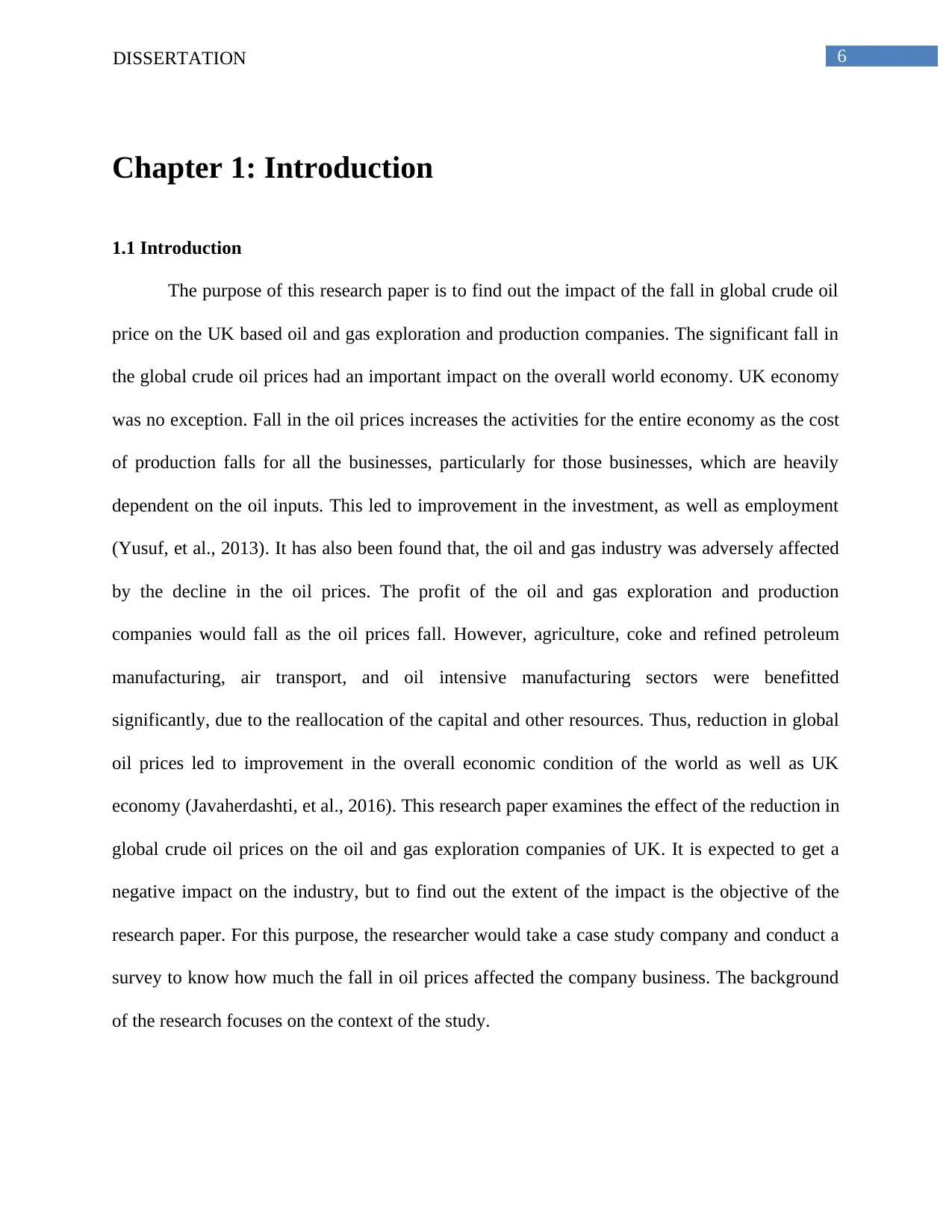
6DISSERTATION
Chapter 1: Introduction
1.1 Introduction
The purpose of this research paper is to find out the impact of the fall in global crude oil
price on the UK based oil and gas exploration and production companies. The significant fall in
the global crude oil prices had an important impact on the overall world economy. UK economy
was no exception. Fall in the oil prices increases the activities for the entire economy as the cost
of production falls for all the businesses, particularly for those businesses, which are heavily
dependent on the oil inputs. This led to improvement in the investment, as well as employment
(Yusuf, et al., 2013). It has also been found that, the oil and gas industry was adversely affected
by the decline in the oil prices. The profit of the oil and gas exploration and production
companies would fall as the oil prices fall. However, agriculture, coke and refined petroleum
manufacturing, air transport, and oil intensive manufacturing sectors were benefitted
significantly, due to the reallocation of the capital and other resources. Thus, reduction in global
oil prices led to improvement in the overall economic condition of the world as well as UK
economy (Javaherdashti, et al., 2016). This research paper examines the effect of the reduction in
global crude oil prices on the oil and gas exploration companies of UK. It is expected to get a
negative impact on the industry, but to find out the extent of the impact is the objective of the
research paper. For this purpose, the researcher would take a case study company and conduct a
survey to know how much the fall in oil prices affected the company business. The background
of the research focuses on the context of the study.
Chapter 1: Introduction
1.1 Introduction
The purpose of this research paper is to find out the impact of the fall in global crude oil
price on the UK based oil and gas exploration and production companies. The significant fall in
the global crude oil prices had an important impact on the overall world economy. UK economy
was no exception. Fall in the oil prices increases the activities for the entire economy as the cost
of production falls for all the businesses, particularly for those businesses, which are heavily
dependent on the oil inputs. This led to improvement in the investment, as well as employment
(Yusuf, et al., 2013). It has also been found that, the oil and gas industry was adversely affected
by the decline in the oil prices. The profit of the oil and gas exploration and production
companies would fall as the oil prices fall. However, agriculture, coke and refined petroleum
manufacturing, air transport, and oil intensive manufacturing sectors were benefitted
significantly, due to the reallocation of the capital and other resources. Thus, reduction in global
oil prices led to improvement in the overall economic condition of the world as well as UK
economy (Javaherdashti, et al., 2016). This research paper examines the effect of the reduction in
global crude oil prices on the oil and gas exploration companies of UK. It is expected to get a
negative impact on the industry, but to find out the extent of the impact is the objective of the
research paper. For this purpose, the researcher would take a case study company and conduct a
survey to know how much the fall in oil prices affected the company business. The background
of the research focuses on the context of the study.
Paraphrase This Document
Need a fresh take? Get an instant paraphrase of this document with our AI Paraphraser
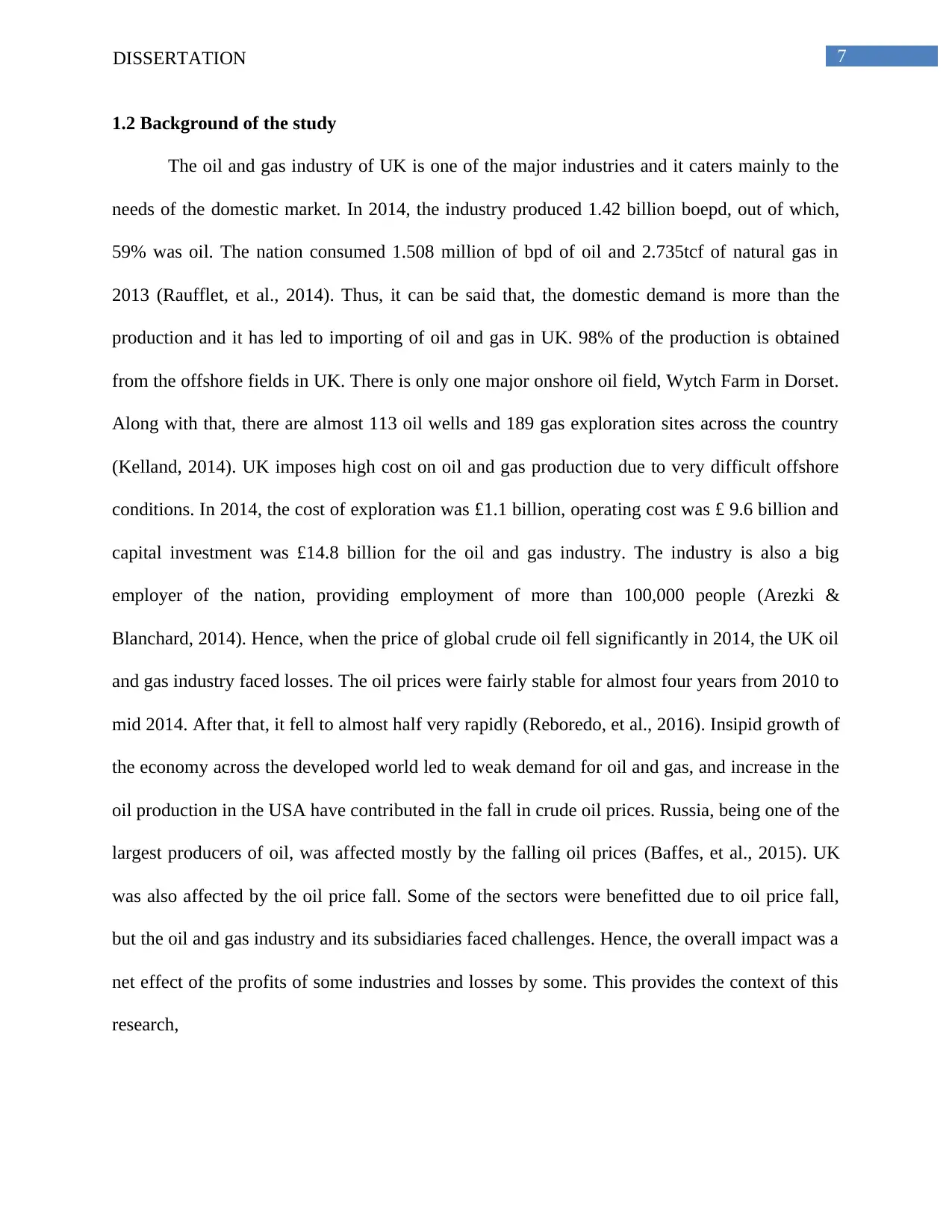
7DISSERTATION
1.2 Background of the study
The oil and gas industry of UK is one of the major industries and it caters mainly to the
needs of the domestic market. In 2014, the industry produced 1.42 billion boepd, out of which,
59% was oil. The nation consumed 1.508 million of bpd of oil and 2.735tcf of natural gas in
2013 (Raufflet, et al., 2014). Thus, it can be said that, the domestic demand is more than the
production and it has led to importing of oil and gas in UK. 98% of the production is obtained
from the offshore fields in UK. There is only one major onshore oil field, Wytch Farm in Dorset.
Along with that, there are almost 113 oil wells and 189 gas exploration sites across the country
(Kelland, 2014). UK imposes high cost on oil and gas production due to very difficult offshore
conditions. In 2014, the cost of exploration was £1.1 billion, operating cost was £ 9.6 billion and
capital investment was £14.8 billion for the oil and gas industry. The industry is also a big
employer of the nation, providing employment of more than 100,000 people (Arezki &
Blanchard, 2014). Hence, when the price of global crude oil fell significantly in 2014, the UK oil
and gas industry faced losses. The oil prices were fairly stable for almost four years from 2010 to
mid 2014. After that, it fell to almost half very rapidly (Reboredo, et al., 2016). Insipid growth of
the economy across the developed world led to weak demand for oil and gas, and increase in the
oil production in the USA have contributed in the fall in crude oil prices. Russia, being one of the
largest producers of oil, was affected mostly by the falling oil prices (Baffes, et al., 2015). UK
was also affected by the oil price fall. Some of the sectors were benefitted due to oil price fall,
but the oil and gas industry and its subsidiaries faced challenges. Hence, the overall impact was a
net effect of the profits of some industries and losses by some. This provides the context of this
research,
1.2 Background of the study
The oil and gas industry of UK is one of the major industries and it caters mainly to the
needs of the domestic market. In 2014, the industry produced 1.42 billion boepd, out of which,
59% was oil. The nation consumed 1.508 million of bpd of oil and 2.735tcf of natural gas in
2013 (Raufflet, et al., 2014). Thus, it can be said that, the domestic demand is more than the
production and it has led to importing of oil and gas in UK. 98% of the production is obtained
from the offshore fields in UK. There is only one major onshore oil field, Wytch Farm in Dorset.
Along with that, there are almost 113 oil wells and 189 gas exploration sites across the country
(Kelland, 2014). UK imposes high cost on oil and gas production due to very difficult offshore
conditions. In 2014, the cost of exploration was £1.1 billion, operating cost was £ 9.6 billion and
capital investment was £14.8 billion for the oil and gas industry. The industry is also a big
employer of the nation, providing employment of more than 100,000 people (Arezki &
Blanchard, 2014). Hence, when the price of global crude oil fell significantly in 2014, the UK oil
and gas industry faced losses. The oil prices were fairly stable for almost four years from 2010 to
mid 2014. After that, it fell to almost half very rapidly (Reboredo, et al., 2016). Insipid growth of
the economy across the developed world led to weak demand for oil and gas, and increase in the
oil production in the USA have contributed in the fall in crude oil prices. Russia, being one of the
largest producers of oil, was affected mostly by the falling oil prices (Baffes, et al., 2015). UK
was also affected by the oil price fall. Some of the sectors were benefitted due to oil price fall,
but the oil and gas industry and its subsidiaries faced challenges. Hence, the overall impact was a
net effect of the profits of some industries and losses by some. This provides the context of this
research,
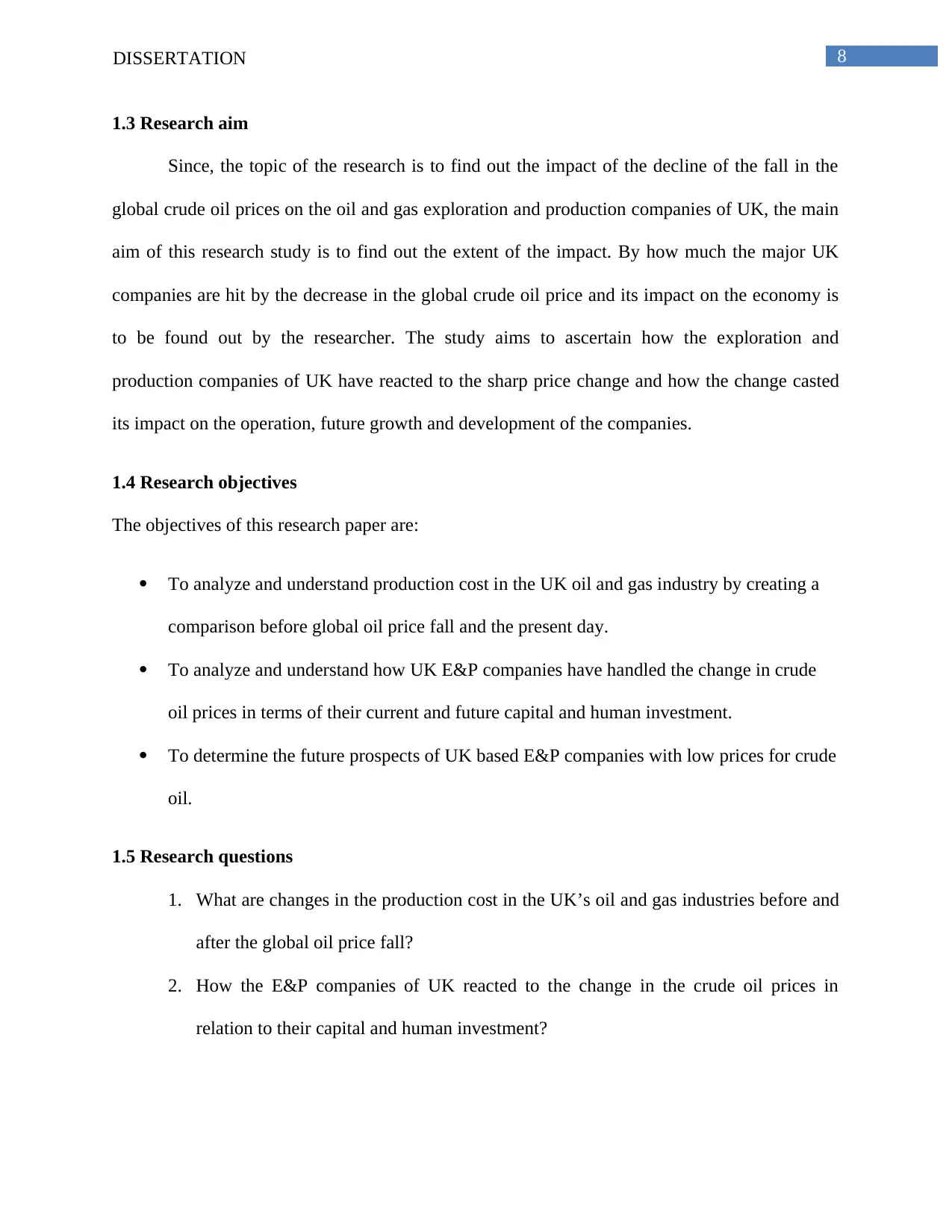
8DISSERTATION
1.3 Research aim
Since, the topic of the research is to find out the impact of the decline of the fall in the
global crude oil prices on the oil and gas exploration and production companies of UK, the main
aim of this research study is to find out the extent of the impact. By how much the major UK
companies are hit by the decrease in the global crude oil price and its impact on the economy is
to be found out by the researcher. The study aims to ascertain how the exploration and
production companies of UK have reacted to the sharp price change and how the change casted
its impact on the operation, future growth and development of the companies.
1.4 Research objectives
The objectives of this research paper are:
To analyze and understand production cost in the UK oil and gas industry by creating a
comparison before global oil price fall and the present day.
To analyze and understand how UK E&P companies have handled the change in crude
oil prices in terms of their current and future capital and human investment.
To determine the future prospects of UK based E&P companies with low prices for crude
oil.
1.5 Research questions
1. What are changes in the production cost in the UK’s oil and gas industries before and
after the global oil price fall?
2. How the E&P companies of UK reacted to the change in the crude oil prices in
relation to their capital and human investment?
1.3 Research aim
Since, the topic of the research is to find out the impact of the decline of the fall in the
global crude oil prices on the oil and gas exploration and production companies of UK, the main
aim of this research study is to find out the extent of the impact. By how much the major UK
companies are hit by the decrease in the global crude oil price and its impact on the economy is
to be found out by the researcher. The study aims to ascertain how the exploration and
production companies of UK have reacted to the sharp price change and how the change casted
its impact on the operation, future growth and development of the companies.
1.4 Research objectives
The objectives of this research paper are:
To analyze and understand production cost in the UK oil and gas industry by creating a
comparison before global oil price fall and the present day.
To analyze and understand how UK E&P companies have handled the change in crude
oil prices in terms of their current and future capital and human investment.
To determine the future prospects of UK based E&P companies with low prices for crude
oil.
1.5 Research questions
1. What are changes in the production cost in the UK’s oil and gas industries before and
after the global oil price fall?
2. How the E&P companies of UK reacted to the change in the crude oil prices in
relation to their capital and human investment?
⊘ This is a preview!⊘
Do you want full access?
Subscribe today to unlock all pages.

Trusted by 1+ million students worldwide
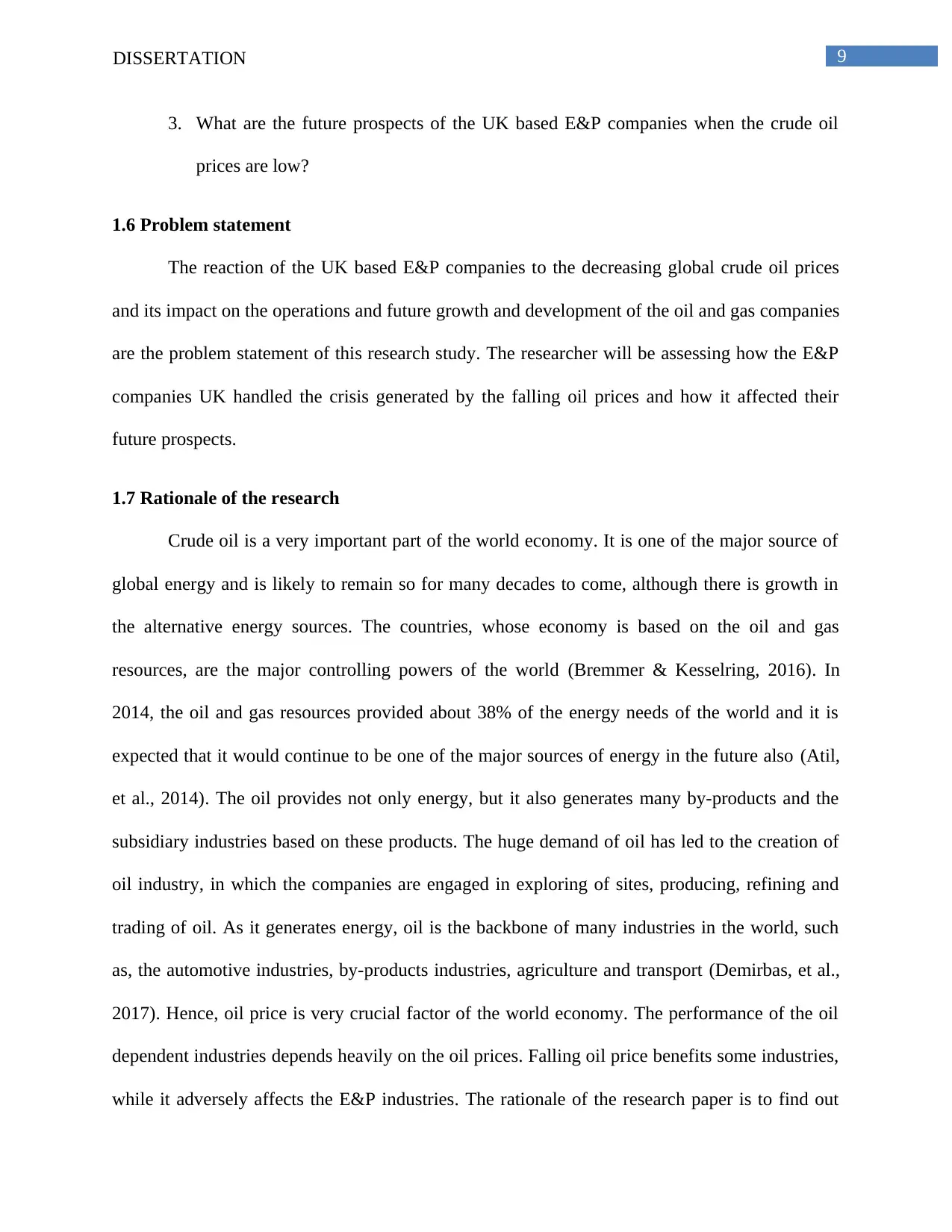
9DISSERTATION
3. What are the future prospects of the UK based E&P companies when the crude oil
prices are low?
1.6 Problem statement
The reaction of the UK based E&P companies to the decreasing global crude oil prices
and its impact on the operations and future growth and development of the oil and gas companies
are the problem statement of this research study. The researcher will be assessing how the E&P
companies UK handled the crisis generated by the falling oil prices and how it affected their
future prospects.
1.7 Rationale of the research
Crude oil is a very important part of the world economy. It is one of the major source of
global energy and is likely to remain so for many decades to come, although there is growth in
the alternative energy sources. The countries, whose economy is based on the oil and gas
resources, are the major controlling powers of the world (Bremmer & Kesselring, 2016). In
2014, the oil and gas resources provided about 38% of the energy needs of the world and it is
expected that it would continue to be one of the major sources of energy in the future also (Atil,
et al., 2014). The oil provides not only energy, but it also generates many by-products and the
subsidiary industries based on these products. The huge demand of oil has led to the creation of
oil industry, in which the companies are engaged in exploring of sites, producing, refining and
trading of oil. As it generates energy, oil is the backbone of many industries in the world, such
as, the automotive industries, by-products industries, agriculture and transport (Demirbas, et al.,
2017). Hence, oil price is very crucial factor of the world economy. The performance of the oil
dependent industries depends heavily on the oil prices. Falling oil price benefits some industries,
while it adversely affects the E&P industries. The rationale of the research paper is to find out
3. What are the future prospects of the UK based E&P companies when the crude oil
prices are low?
1.6 Problem statement
The reaction of the UK based E&P companies to the decreasing global crude oil prices
and its impact on the operations and future growth and development of the oil and gas companies
are the problem statement of this research study. The researcher will be assessing how the E&P
companies UK handled the crisis generated by the falling oil prices and how it affected their
future prospects.
1.7 Rationale of the research
Crude oil is a very important part of the world economy. It is one of the major source of
global energy and is likely to remain so for many decades to come, although there is growth in
the alternative energy sources. The countries, whose economy is based on the oil and gas
resources, are the major controlling powers of the world (Bremmer & Kesselring, 2016). In
2014, the oil and gas resources provided about 38% of the energy needs of the world and it is
expected that it would continue to be one of the major sources of energy in the future also (Atil,
et al., 2014). The oil provides not only energy, but it also generates many by-products and the
subsidiary industries based on these products. The huge demand of oil has led to the creation of
oil industry, in which the companies are engaged in exploring of sites, producing, refining and
trading of oil. As it generates energy, oil is the backbone of many industries in the world, such
as, the automotive industries, by-products industries, agriculture and transport (Demirbas, et al.,
2017). Hence, oil price is very crucial factor of the world economy. The performance of the oil
dependent industries depends heavily on the oil prices. Falling oil price benefits some industries,
while it adversely affects the E&P industries. The rationale of the research paper is to find out
Paraphrase This Document
Need a fresh take? Get an instant paraphrase of this document with our AI Paraphraser
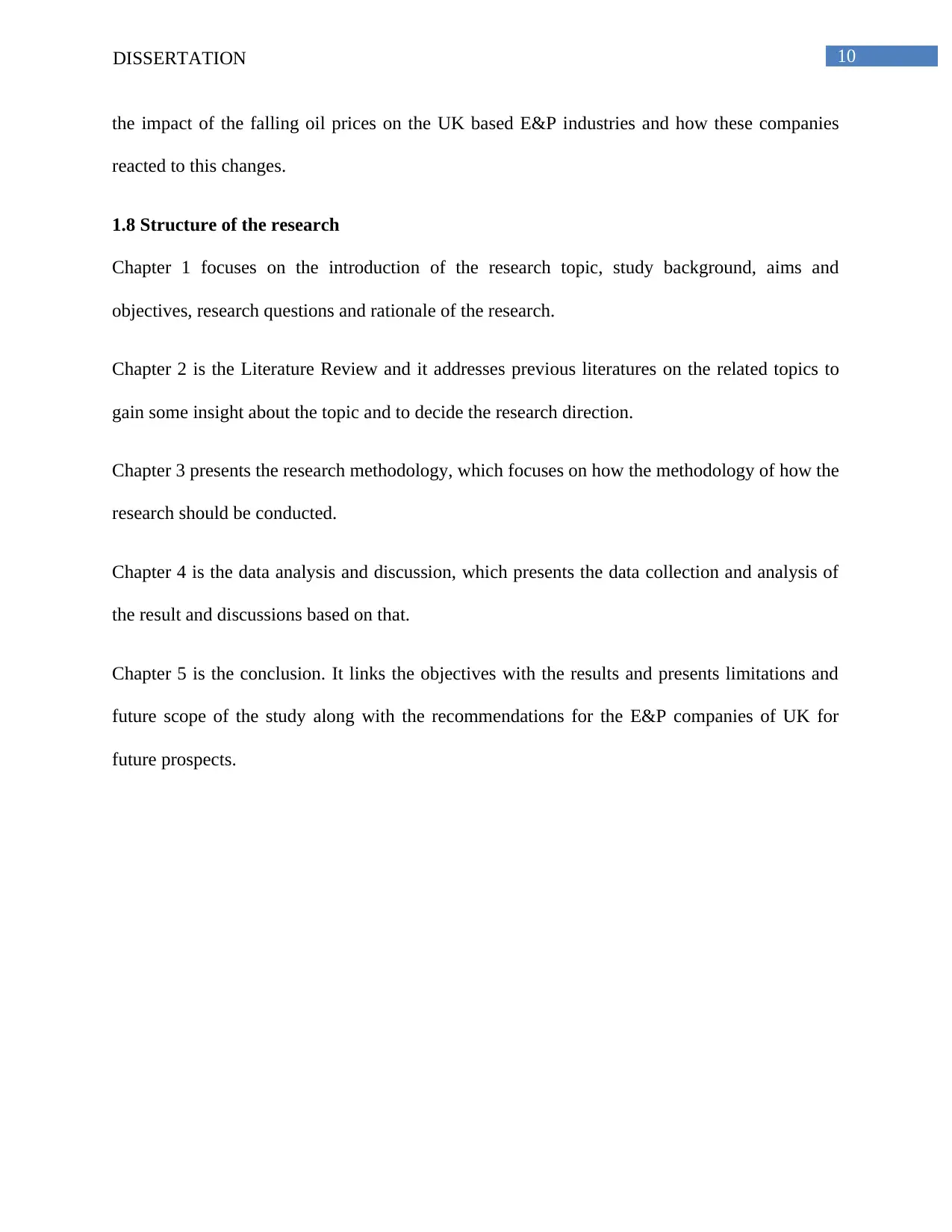
10DISSERTATION
the impact of the falling oil prices on the UK based E&P industries and how these companies
reacted to this changes.
1.8 Structure of the research
Chapter 1 focuses on the introduction of the research topic, study background, aims and
objectives, research questions and rationale of the research.
Chapter 2 is the Literature Review and it addresses previous literatures on the related topics to
gain some insight about the topic and to decide the research direction.
Chapter 3 presents the research methodology, which focuses on how the methodology of how the
research should be conducted.
Chapter 4 is the data analysis and discussion, which presents the data collection and analysis of
the result and discussions based on that.
Chapter 5 is the conclusion. It links the objectives with the results and presents limitations and
future scope of the study along with the recommendations for the E&P companies of UK for
future prospects.
the impact of the falling oil prices on the UK based E&P industries and how these companies
reacted to this changes.
1.8 Structure of the research
Chapter 1 focuses on the introduction of the research topic, study background, aims and
objectives, research questions and rationale of the research.
Chapter 2 is the Literature Review and it addresses previous literatures on the related topics to
gain some insight about the topic and to decide the research direction.
Chapter 3 presents the research methodology, which focuses on how the methodology of how the
research should be conducted.
Chapter 4 is the data analysis and discussion, which presents the data collection and analysis of
the result and discussions based on that.
Chapter 5 is the conclusion. It links the objectives with the results and presents limitations and
future scope of the study along with the recommendations for the E&P companies of UK for
future prospects.
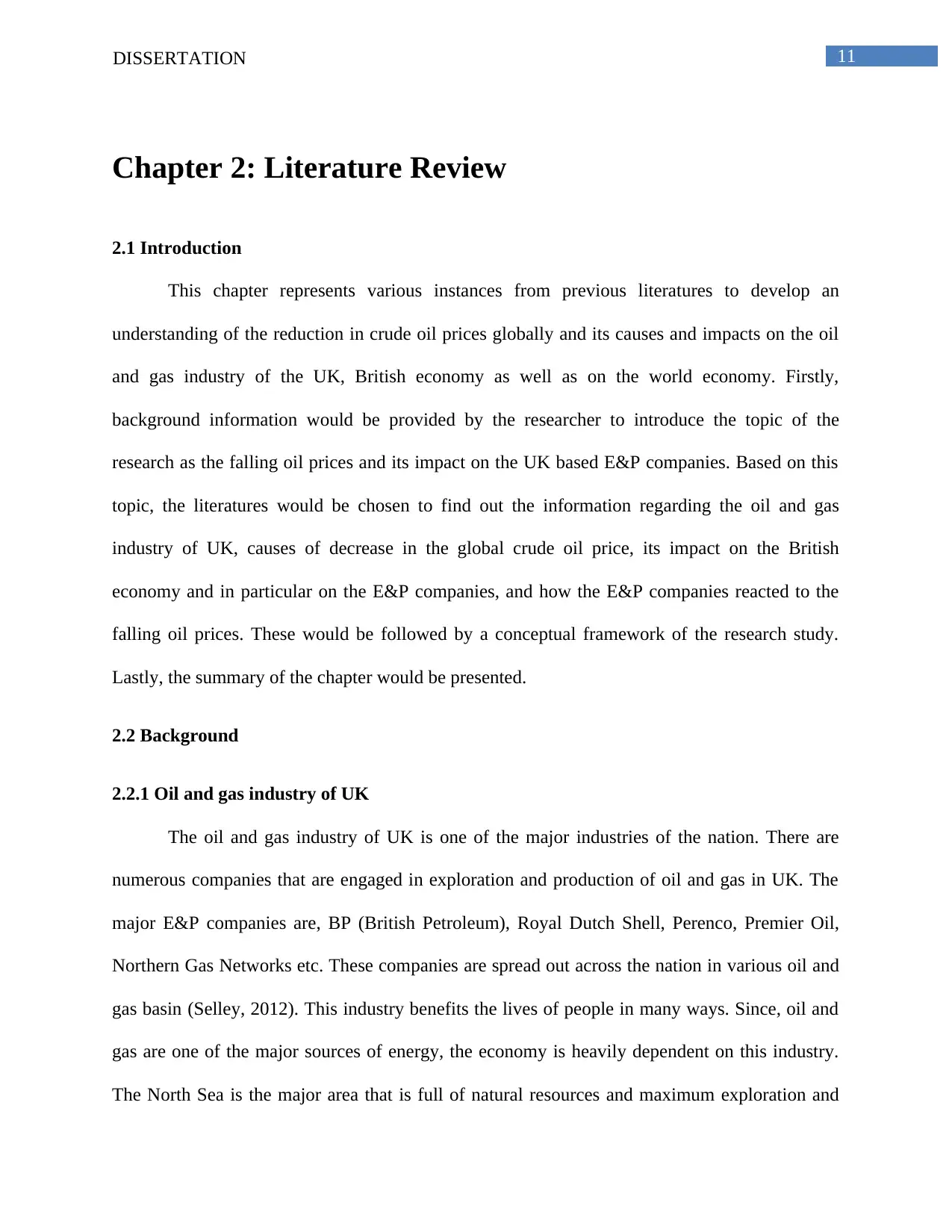
11DISSERTATION
Chapter 2: Literature Review
2.1 Introduction
This chapter represents various instances from previous literatures to develop an
understanding of the reduction in crude oil prices globally and its causes and impacts on the oil
and gas industry of the UK, British economy as well as on the world economy. Firstly,
background information would be provided by the researcher to introduce the topic of the
research as the falling oil prices and its impact on the UK based E&P companies. Based on this
topic, the literatures would be chosen to find out the information regarding the oil and gas
industry of UK, causes of decrease in the global crude oil price, its impact on the British
economy and in particular on the E&P companies, and how the E&P companies reacted to the
falling oil prices. These would be followed by a conceptual framework of the research study.
Lastly, the summary of the chapter would be presented.
2.2 Background
2.2.1 Oil and gas industry of UK
The oil and gas industry of UK is one of the major industries of the nation. There are
numerous companies that are engaged in exploration and production of oil and gas in UK. The
major E&P companies are, BP (British Petroleum), Royal Dutch Shell, Perenco, Premier Oil,
Northern Gas Networks etc. These companies are spread out across the nation in various oil and
gas basin (Selley, 2012). This industry benefits the lives of people in many ways. Since, oil and
gas are one of the major sources of energy, the economy is heavily dependent on this industry.
The North Sea is the major area that is full of natural resources and maximum exploration and
Chapter 2: Literature Review
2.1 Introduction
This chapter represents various instances from previous literatures to develop an
understanding of the reduction in crude oil prices globally and its causes and impacts on the oil
and gas industry of the UK, British economy as well as on the world economy. Firstly,
background information would be provided by the researcher to introduce the topic of the
research as the falling oil prices and its impact on the UK based E&P companies. Based on this
topic, the literatures would be chosen to find out the information regarding the oil and gas
industry of UK, causes of decrease in the global crude oil price, its impact on the British
economy and in particular on the E&P companies, and how the E&P companies reacted to the
falling oil prices. These would be followed by a conceptual framework of the research study.
Lastly, the summary of the chapter would be presented.
2.2 Background
2.2.1 Oil and gas industry of UK
The oil and gas industry of UK is one of the major industries of the nation. There are
numerous companies that are engaged in exploration and production of oil and gas in UK. The
major E&P companies are, BP (British Petroleum), Royal Dutch Shell, Perenco, Premier Oil,
Northern Gas Networks etc. These companies are spread out across the nation in various oil and
gas basin (Selley, 2012). This industry benefits the lives of people in many ways. Since, oil and
gas are one of the major sources of energy, the economy is heavily dependent on this industry.
The North Sea is the major area that is full of natural resources and maximum exploration and
⊘ This is a preview!⊘
Do you want full access?
Subscribe today to unlock all pages.

Trusted by 1+ million students worldwide
1 out of 54
Related Documents
Your All-in-One AI-Powered Toolkit for Academic Success.
+13062052269
info@desklib.com
Available 24*7 on WhatsApp / Email
![[object Object]](/_next/static/media/star-bottom.7253800d.svg)
Unlock your academic potential
Copyright © 2020–2026 A2Z Services. All Rights Reserved. Developed and managed by ZUCOL.





